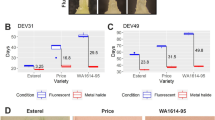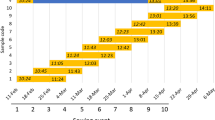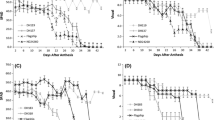Abstract
Winterhardiness has three primary components: photoperiod (day length) sensitivity, vernalization response, and low temperature tolerance. Photoperiod and vernalization regulate the vegetative to reproductive phase transition, and photoperiod regulates expression of key vernalization genes. Using two barley mapping populations, we mapped six individual photoperiod response QTL and determined their positional relationship to the phytochrome and cryptochrome photoreceptor gene families and the vernalization regulatory genes HvBM5A, ZCCT-H, and HvVRT-2. Of the six photoreceptors mapped in the current study (HvPhyA and HvPhyB to 4HS, HvPhyC to 5HL, HvCry1a and HvCry2 to 6HS, and HvCry1b to 2HL), only HvPhyC coincided with a photoperiod response QTL. We recently mapped the candidate genes for the 5HL VRN-H1 (HvBM5A) and 4HL VRN-H2 (ZCCT-H) loci, and in this study, we mapped HvVRT-2, the barley TaVRT-2 ortholog (a wheat flowering repressor regulated by vernalization and photoperiod) to 7HS. Each of these three vernalization genes is located in chromosome regions determining small photoperiod response QTL effects. HvBM5A and HvPhyC are closely linked on 5HL and therefore are currently both positional candidates for the same photoperiod effect. The coincidence of photoperiod-responsive vernalization genes with photoperiod QTL suggests vernalization genes should also be considered candidates for photoperiod effects.

Similar content being viewed by others
References
Beales J, Laurie DA, Devos KM (2005) Allelic variation at the linked AP1 and PhyC loci in hexaploid wheat is associated but not perfectly correlated with vernalization response. Theor Appl Genet 110:1099–1107
Biyashev RM, Ragab RA, Maughan PJ, Saghai Maroof MA (1997) Molecular mapping, chromosomal assignment, and genetic diversity analysis of phytochrome loci in barley (Hordeum vulgare). J Hered 88:21–26
Cashmore AR, Jarillo JA, Wu YJ, Liu D (1999) Cryptochromes: blue light receptors for plants and animals. Science 284:760–765
Danyluk J, Kane NA, Breton G, Limin A, Fowler DB, Sarhan F (2003) TaVRT-1, a putative transcription factor associated with vegetative reproductive transition in cereals. Plant Physiol 132:1849–1860
Devos KM, Beales J, Ogihara Y, Doust AN (2005) Comparative sequence analysis of the Phytochrome C gene and its upstream region in allohexaploid wheat reveals new data on the evolution of its three constituent genomes. Plant Mol Biol 58:625–641
Dubcovsky J, Chen C, Khan IA, Yan L (2005) Molecular characterization of the allelic variation at the VRN-H2 vernalization locus in barley. Mol Breed 15:395–407
Fowler DB, Breton G, Limin AE, Mahfoozi S, Sarhan F (2001) Photoperiod and temperature interactions regulate low-temperature-induced gene expression in barley. Plant Physiol 127:1676–1681
Griffiths S, Dunford RP, Coupland G, Laurie DA (2003) The evolution of CONSTANS-like gene families in barley, rice, and Arabidopsis. Plant Physiol 131:1855–1867
Hanumappa M, Pratt LH, Cordonnier-Pratt MM, Deitzer GF (1999) A photoperiod-insensitive barley line contains a light-labile phytochrome B. Plant Physiol 119:1033–1039
Hayes PM, Chen FQ, Corey A, Pan A, Chen THH, Baird E, Powell W, Thomas W, Waugh R, Bedo Z, Karsai I, Blake T, Oberthur L (1997) The Dicktoo x Morex population: a model for dissecting components of winterhardiness in barley. In: Li PH, Chen THH (eds) Plant Cold Hardiness. Plenum Press, New York, pp 77–87
Huq E, Quail PH (2002) PIF4, a phytochrome-interacting bHLH factor, functions as a negative regulator of phytochrome B signaling in Arabidopsis. EMBO J 21:2441–2450
Islam AKMR, Shepherd KW, Sparrow DHB (1981) Isolation and characterization of euplasmic wheat-barley chromosome addition lines. Heredity 46:161–174
Kane NA, Danyluk J, Tardif G, Ouellet F, Laliberte´ J, Limin AE, Fowler DB, Sarhan F (2005) TaVRT-2, a member of the StMADS-11 clade of flowering repressors, is regulated by vernalization and photoperiod in wheat. Plant Physiol 138:2354–2363
Karsai I, Szűcs P, Mészáros K, Filichkina T, Hayes PM, Skinner JS, Láng L, Bedő Z (2005) The Vrn-H2 locus is a major determinant of flowering time in a facultative × winter growth habit barley (Hordeum vulgare L.) mapping population. Theor Appl Genet 110:1458–1466
Kleinhofs A, Graner A (2001) An integrated map of the barley genome. In: Phillips RL, Vasil IK (eds) DNA-based markers in plants. Kluwer, Dordrecht, pp 187–199
Laurie DA, Pratchett N, Bezant JH, Snape JW (1995) RFLP mapping of five major genes and eight quantitative trait loci controlling flowering time in a winter × spring barley (Hordeum vulgare L.) cross. Genome 38:575–585
Limin AE, Fowler DB (2002) Developmental traits affecting low-temperature tolerance response in near-isogenic lines for the vernalization locus Vrn-A1 in wheat (Triticum aestivum L. em Thell). Ann Bot 89:579–585
Lin C (2000). Photoreceptors and regulation of flowering time. Plant Physiol 123:39–50
Mahfoozi S, Limin AE, Fowler DB (2001) Influence of vernalization and photoperiod responses on cold hardiness in winter cereals. Crop Sci 41:1006–1011
Mathews S, Sharrock RA (1996) The phytochrome gene family in grasses (Poaceae): a phylogeny and evidence that grasses have a subset of the loci found in dicot angiosperms. Mol Biol Evol 13:1141–1150
Mockler T, Yang H, Yu X, Parikh D, Cheng Y, Dolan S, Lin C (2003) Regulation of photoperiodic flowering by Arabidopsis photoreceptors. Proc Natl Acad Sci USA 100:2140–2145
Monte E, Alonso JM, Ecker JR, Zhang Y, Li X, Young J, Austin-Phillips S, Quail PH (2003) Isolation and characterization of phyC mutants in Arabidopsis reveals complex crosstalk between phytochrome signaling pathways. Plant Cell 15:1962–1980
Murai K, Miyamae M, Kato H, Takumi S, Ogihara Y (2003) WAP1, a wheat APETALA1 homolog, plays a central role in the phase transition from vegetative to reproductive growth. Plant Cell Physiol 44:1255–1265
Mouradov A, Cremer F, Coupland G (2002) Control of flowering time: interacting pathways as a basis for diversity. Plant Cell 14:S111–S130
Perrotta G, Yahoubyan G, Nebuloso E, Renzi L, Giuliano G (2001) Tomato and barley contain duplicated copies of cryptochrome 1. Plant Cell Environ 24:991–997
Quail PH (2002) Photosensory perception and signalling in plant cells: new paradigms? Curr Opin Cell Biol 14:180–188
Skinner JS, Szűcs P, von Zitzewitz J, Marquez-Cedillo L, Filichkin T, Stockinger EJ, Thomashow MF, Chen THH, Hayes PM (2006) Mapping of barley homologs to genes that regulate low temperature tolerance in Arabidopsis. Theor Appl Genet 112. DOI 10.1007/s00122-005-0185-y
Skinner JS, von Zitzewitz J, Szűcs P, Marquez-Cedillo L, Filichkin T, Amundsen K, Stockinger EJ, Thomashow MF, Chen THH, Hayes PM (2005) Structural, functional, and phylogenetic characterization of a large CBF gene family in barley. Plant Mol Biol 59:533–551
Sullivan JA, Deng XW (2003) From seed to seed: the role of photoreceptors in Arabidopsis development. Dev Biol 260:289–297
Takano M, Inagaki N, Xie X, Yuzurihara N, Hihara F, Ishizuka T, Yano M, Nishimura M, Miyao A, Hirochika H, Shinomura T (2005) Distinct and cooperative functions of phytochromes A, B, and C in the control of deetiolation and flowering in rice. Plant Cell 17:3311–3325
Trevaskis B, Bagnall DJ, Ellis MH, Peacocck WJ, Dennis ES (2003) MADS box genes control vernalization-induced flowering in cereals. Proc Natl Acad Sci USA 100:13099–13104
Turner A, Beales J, Faure S, Dunford RP, Laurie DA (2005) The pseudo-response regulator Ppd-H1 provides adaptation to photoperiod in barley. Science 310:1031–1034
Van Ooijen JW, Voorrips RE (2001) JoinMap® 3.0, Software for the calculation of genetic linkage maps. Plant Research International, Wageningen, Netherlands
Vince-Prue D (1975) Photoperiodism in Plants. McGraw-Hill, London
von Zitzewitz J, Szűcs P, Dubcovsky J, Yan L, Pecchioni N, Francia E, Casas A, Chen THH, Hayes PM, Skinner JS (2005) Molecular and structural characterization of barley vernalization genes. Plant Mol Biol 59:449–467
Wang S, Basten CJ, Zeng Z-B (2005) Windows QTL Cartographer 2.5. North Carolina State University, Raleigh, NC (http://www.statgen.ncsu.edu/qtlcart/WQTLCart.htm)
Yan L, Loukoianov A, Blechl A, Tranquilli G, Ramakrishna W, SanMiguel P, Bennetzen JL, Echenique V, Dubcovsky J (2004) The wheat VRN2 gene is a flowering repressor down-regulated by vernalization. Science 303:1640–1644
Yan L, Loukoianov A, Tranquilli G, Helguera M, Fahima T, Dubcovsky J (2003) Positional cloning of the wheat vernalization gene VRN1. Proc Natl Acad Sci USA 100:6263–6268
Yan L, von Zitzewitz J, Skinner JS, Hayes PM, Dubcovsky J (2005) Molecular characterization of the duplicated meristem identity genes HvAP1a and HvAP1b in barley. Genome 48:905–912
Acknowledgements
We wish to thank Olin Anderson and Devin Coleman-Derr (USDA-ARS, Albany) for their help with sequencing BAC clone 631P8, David Laurie (JIC, Norwich) for sharing HvPhyC and Fathey Sarhan (UQM, Montreal) for sharing TaVRT-2 sequence data prior to publication, and Kazuhiro Sato (RIB, Kurashiki) for supplying cDNA clones. This work was supported by an NSF Functional Genomics grant 0110124, and the USDA/CSREES United States Barley Genome Project.
Author information
Authors and Affiliations
Corresponding author
Additional information
Communicated by J. W. Snape
Rights and permissions
About this article
Cite this article
Szűcs, P., Karsai, I., von Zitzewitz, J. et al. Positional relationships between photoperiod response QTL and photoreceptor and vernalization genes in barley. Theor Appl Genet 112, 1277–1285 (2006). https://doi.org/10.1007/s00122-006-0229-y
Received:
Accepted:
Published:
Issue Date:
DOI: https://doi.org/10.1007/s00122-006-0229-y




